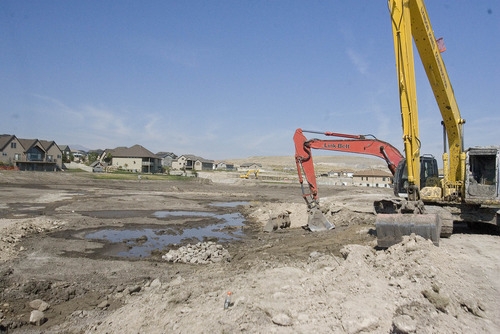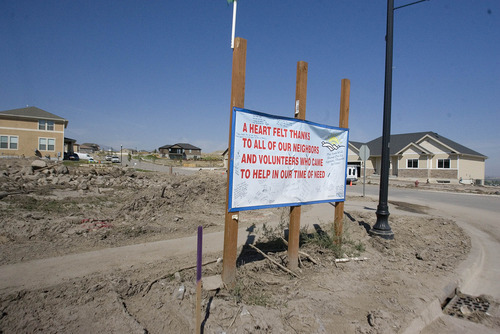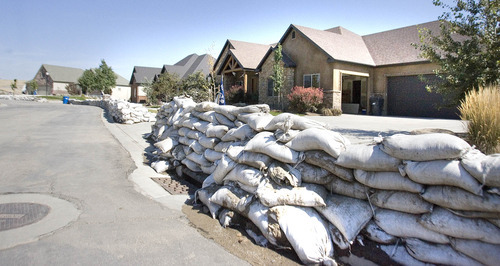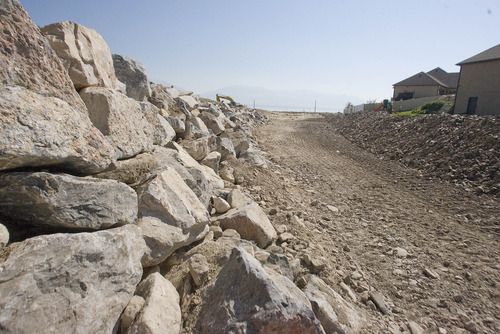This is an archived article that was published on sltrib.com in 2012, and information in the article may be outdated. It is provided only for personal research purposes and may not be reprinted.
A dark, thundering cloud overhead brought chaos, destruction and tears to a Utah County community earlier this month, but now Saratoga Springs has a temporary fix to the problem of debris flow.
Friday was the first day off for public works and other city workers in Saratoga Springs in two weeks, said Saratoga Springs City Manager Mark Christensen.
He said crews have been working up to 16 hours a day for a total of about 200 hours to clean up the hillside and mitigate further damage from happening.
"Any people that could operate machinery we had them on machinery," Christensen said of city workers.
The cleanup was a joint effort from surrounding communities that "stepped up to help [the city] recover" donating equipment and time, Christensen said. More than 5,000 volunteers armed with energy arrived to help residents, some areas in Saratoga Springs even canceled church meetings to help fellow neighbors clean up after torrential downpours drove water and mud from the recent Dump Fire burn scar down the mountain on Sept. 1.About 24 homes were damaged.
When a fire burns a mountain it doesn't just remove vegetation, it creates a slippery slide for water.
Nanette Hosenfeld, meteorologist with the National Weather Service said when a fire burns vegetation, the oils and other fluids inside the plants fall onto the soil and create a water repellent barrier.
"It is like putting a Goretex jacket over the ground," Hosenfeld said, adding a higher flow of water comes off the mountain than if the area hadn't been burned.
During Saratoga Springs' recent disaster, water carried debris down the mountain and became jammed at three culverts flowing into a retention pond and cut off the ability for water to pass through, so it went somewhere else.
It wasn't something the city was prepared for and something they couldn't predict.
"We didn't have equipment that could do it," Christensen said. "We had to rent it."
The most common kind of mitigation is for communities to have a debris basin, according to senior geologist at the Utah Geological Survey Rich Giraud. He said usually it takes a city a few incidents to decide to put one in. Saratoga Springs had a storm drain basin, but not a debris flow basin when the recent mudslide hit.
"You really can't prevent the natural hazards from happening," Giraud said. "What we try to do is educate communities and to also build hazard resistant communities."
Saratoga Springs was given $220,000 in government funds as a result of the Dump Fire to take care of the damage caused. About 5,500 acres were charred, and a steep slope was left nearly barren with sporadic clumps of vegetation. The Bureau of Land Management had planned a reseeding of the hillside for mid-October for about five-square miles of federal land.
But before that plan came together, disaster struck. Christensen said a plan to mitigate disaster was in the process shortly before the mudslide, but funding hadn't been finalized by the federal government. He said it takes time when working with other agencies to fund projects.
"It's just very unfortunate the flood came before we completed these projects," he said.
As soon as a declaration of emergency went into place after the mudslides, Saratoga Springs recieved approval for funding to do the projects they had planned.
Because of the recent mudslide, the city is now scheduled to receive close to $500,000 for repairs from the debris flow. But city officials are doubtful those funds will cover the cost incurred.
The debris flow at the Dump Fire was more liquefied than some debris flows, because it had 50/50 mix of rain water and debris, Giraud said. The watery flow came roaring down stream channels and eroding the sides and eventually spread out above and around the city.
As the mud and water was shoveled from the streets and homes, spillways were being created, a drainage channel was dug out, widened and reinforced at the curves with six feet high of stacked concrete jersey barriers donated from the I-15 Core Project.
Christensen said while a lot of work was done, it just a "short term, immediate fix" and more permanent work will need to be done later.
When the next storm comes, Christensen said, for now, the city has "got a pretty good defensible position."
Twitter: @CimCity —
Lending a helping hand
To donate or help residents who have been affected visit: http://www.saratogaspringsrelief.blogspot.com











